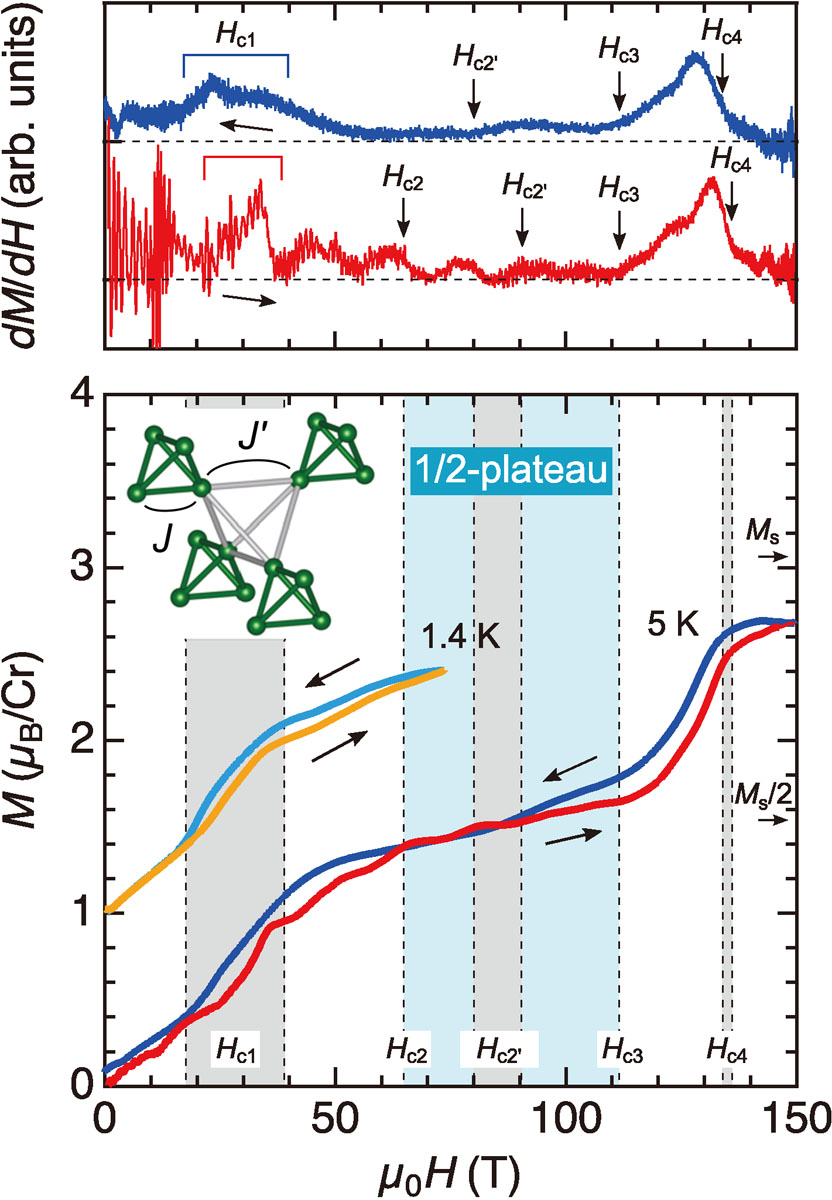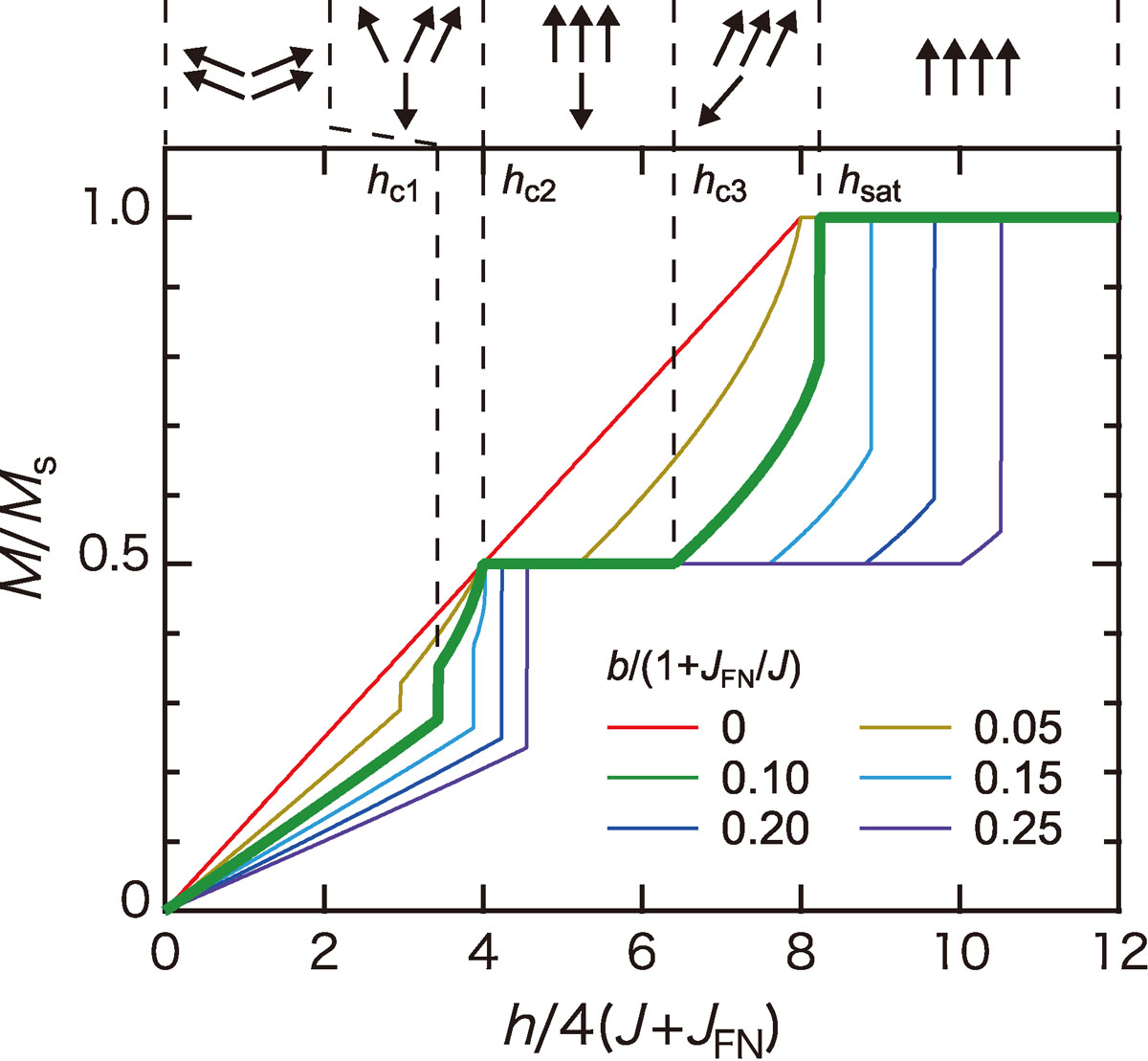Magnetization Process of the Breathing Pyrochlore Magnet CuInCr4S8 in Ultrahigh Magnetic Fields up to 150 T
Kohama Group
Breathing pyrochlore magnets with an alternating array of small and large tetrahedra have recently attracted attention because of their potential realization of exotic magnetic states. One promising candidate is the S = 3/2 chromium spinel oxide, LiInCr4O8, characterized by the small breathing factor J’/J~0.1, where J and J’ are the exchange interactions on the small and large tetrahedra, respectively (inset of Fig. 1) [1]. In this system, the spin-lattice coupling (SLC) as well as the breathing factor govern its magnetic properties, as represented by a tetramer-singlet formation [1] and a field-induced transition to a 1/2-magnetization plateau phase [2]. Another intriguing system is the sulfide, CuInCr4S8, where the antiferromagnetic (AFM) J and the ferromagnetic (FM) J’ coexist [3]. As shown in Fig. 1, the previously reported M-H curves at 1.4 K (orange and cyan lines for up and down sweeps, respectively) show a metamagnetic behavior with a large hysteresis loop at around Hc1 = 20~40 T, while M reaches only 45 % of the saturation magnetization of ~3.06 μB/Cr at 73 T [3].

Fig. 1. M-H curves of CuInCr4S8 measured at ~5 K in a single-turn coil megagauss generator up to 150 T (red and blue curves for up and down sweeps, respectively). Derivatives dM/dH are shown in the upper panel. The previously reported M-H curve measured at 1.4 K up to 73 T are also shown (orange and cyan curves for up and down sweeps, respectively) [3]. Transition fields are denoted by brackets or arrows in the upper panel, and drawn by the shaded areas (first order) or dashed lines (second order) in the lower panel. Inset shows the schematic of the breathing pyrochlore lattice.
In this work, we performed magnetization measurements on a polycrystalline powder sample of CuInCr4S8 by using a single-turn coil system. The observed M-H curve and its derivative dM/dH at 5 K up to 150 T are shown in Fig. 1 (red and blue lines for up and down sweeps, respectively) [4]. Remarkably, a wide 1/2-plateau emerges from Hc2 ~ 65 T to Hc3 ~ 112 T as in Cr spinel oxides. Besides, two inherent features are observed: A slight change in the slope of the M-H curve at Hc2’ ~ 85 T and a shoulder like shape at Hc4 ~ 135 T. Both are accompanied by a hysteresis, suggesting first-order transitions. The saturation is estimated to Hsat ~ 180 T under the assumption that M increases linearly above 150 T, where M already reaches ~2.7 μB/Cr.
For interpreting the observed magnetization process, we constructed an effective spin model mapped onto the fcc lattice, which is derived from the microscopic spin model on the breathing pyrochlore lattice with the SLC as proposed in Ref. [5]. Figure 2 summarizes the calculated M-H curves for given values of the SLC parameter b and the corresponding spin structures. In spite of the simplification in our model, the calculation well reproduces the main feature of the M-H curve of CuInCr4S8, including a relatively wide intermediate (canted 2:1:1) phase as well as the 1/2-plateau phase with collinear 3:1 spin configuration.
It is noteworthy that the M-H curves of LiGaCr4S8 and LiInCr4S8, where the FM interaction J’ is expected to be strong, do not exhibit the 1/2-plateau [3]. Bearing this in mind, the exotic magnetic behaviors on CuInCr4S8 can be attributed to the relatively dominant AFM interactions J+JFN compared to the FM J’, which is achieved only by the moderate breathing distortion in the Cr spinel sulfide. On the other hand, the origins of the hysteretic behaviors on CuInCr4S8 at Hc2’ and Hc4 remain unsolved at the moment. They might originate from the interplay between the SLC and the further neighbor interactions JFN, or the thermal and quantum effects, which are not considered in the present theory. The macroscopic spin structures beyond four sites within small tetrahedra should also be clarified, which is crucial to prove the novelty of the magnetic properties in CuInCr4S8. Further experimental investigations such as magnetostriction, ESR, and magnetocaloric effect measurements in high magnetic fields are ongoing to elucidate the essence of the successive phase transitions.
References
- [1] Y. Okamoto, G. J. Nilsen, J. P. Attfield, and Z. Hiroi, Phys. Rev. Lett. 110, 097203 (2013).
- [2] M. Gen, D. Nakamura, Y. Okamoto, and S. Takeyama, J. Magn. Magn. Mater. 473, 387 (2019).
- [3] Y. Okamoto, M. Mori, N. Katayama, A. Miyake, M. Tokunaga, A. Matsuo, K. Kindo, and K. Takenaka, J. Phys. Soc. Jpn. 87, 034709 (2018).
- [4] M. Gen, Y. Okamoto, M. Mori, K. Takenaka, and Y. Kohama, Phys. Rev. B 101, 054434 (2020).
- [5] K. Aoyama and H. Kawamura, Phys. Rev. B 99, 144406 (2019).

